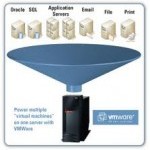Virtualization is a hot topic for many companies because of its savings in power, space and cooling, ease of administration, speedy server deployments and quick return on investment. But what about business continuity and disaster recovery?
What exactly is virtualization?
Virtualization allows you to convert hardware into software. The hardware resources of a computer like the CPU, RAM, hard disk and network interface cards are transformed into a virtual machine that runs its own operating system and application just like a physical computer. Each virtual machine is its own separate entity and unaware that the hardware it’s using is actually shared. This allows multiple virtual machines, with their own name and IP address, to run on one physical server.
What does virtualization have to do with business continuity and disaster recovery?
Business continuity planning and disaster recovery (DR) preparedness are hot topics on every business owner’s mind, especially after Hurricane Ike. Disaster recovery has varying levels, from simple steps for bringing back-up tapes offsite to powering down machines and moving them offsite to efficient full-system restores. Most DR plans focus on high availability of a company’s systems with downtime only lasting minutes and not days.
Double-Take and Neverfail are business continuity software products that focus on data protection, recovery, replication and high availability of a company’s network infrastructure. Their core products allow data and full servers to be replicated in real-time to another physical or virtual machine.
How does it work?
The replication is done at the byte level, which means only the changes of a file are replicated and not the entire file. A heartbeat is setup between the replication partners, and if the production server crashes or is offline for a predefined set of time, the secondary server takes over.
The secondary becomes the primary server and takes ownership of the primary server name, IP address, applications and file shares. The switch is instantaneous and seamless. Users working off the server are unaware of a change in the environment. The secondary or failover servers can be located on the local area network (LAN) or wide area network (WAN). Both Double-Take and Neverfail offer a many-to-one failover for physical to virtual protection.
In the past, each physical server to be replicated required another physical machine to be its partner. This is a financial burden for many because of the cost to maintain twice as many servers. Using virtual machines as recovery targets, companies can now obtain a many-to-one replication and recovery scenario.
Network administrators can leverage VMware virtual ESX Server or Microsoft Virtual Server and Hyper-V as secondary replication partners. Each physical server that requires replication can be setup as a virtual machine on the host virtual machine server. If a physical server requires to be failed over, then the associated virtual machine can be brought online without affecting any of the other virtual machines running on the host server.
Once the primary server is repaired, the secondary server replicates the changes to the primary, and the switch-back to the primary is seamless. By leveraging either Double-Take or Neverfail, you are taking advantage of replication, failover, migration and a physical-to-virtual and virtual-to-physical software suite. In the future, when a small business client asks how many servers are required to protect their entire network, you can safely say, “one!”
Pingback: Return on investment | Money and Finance Articles